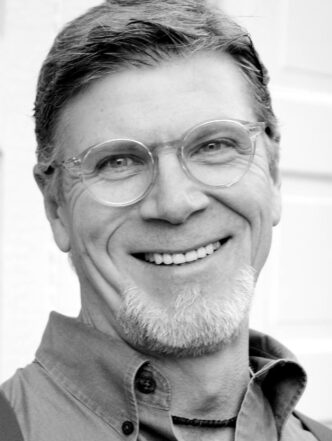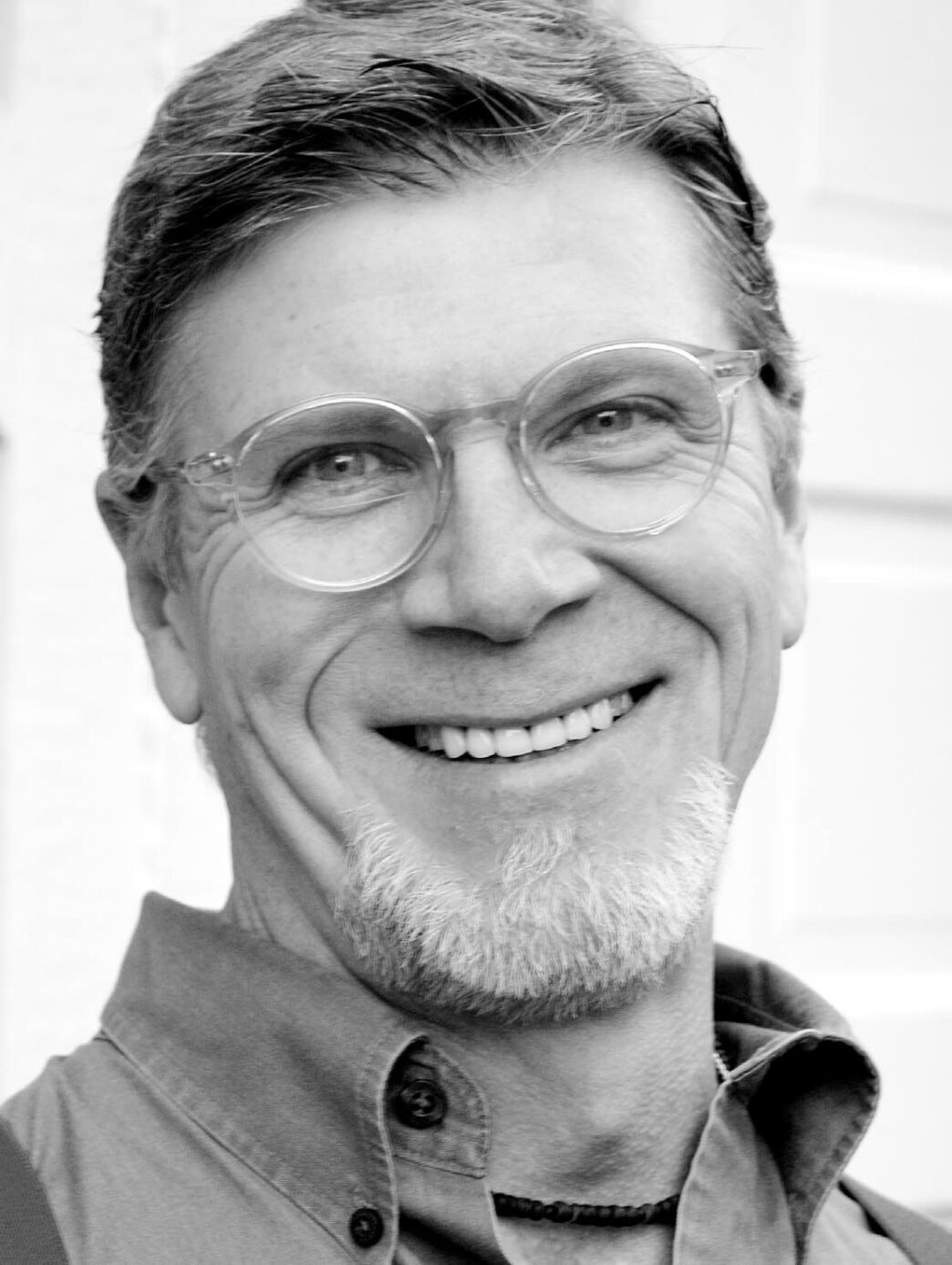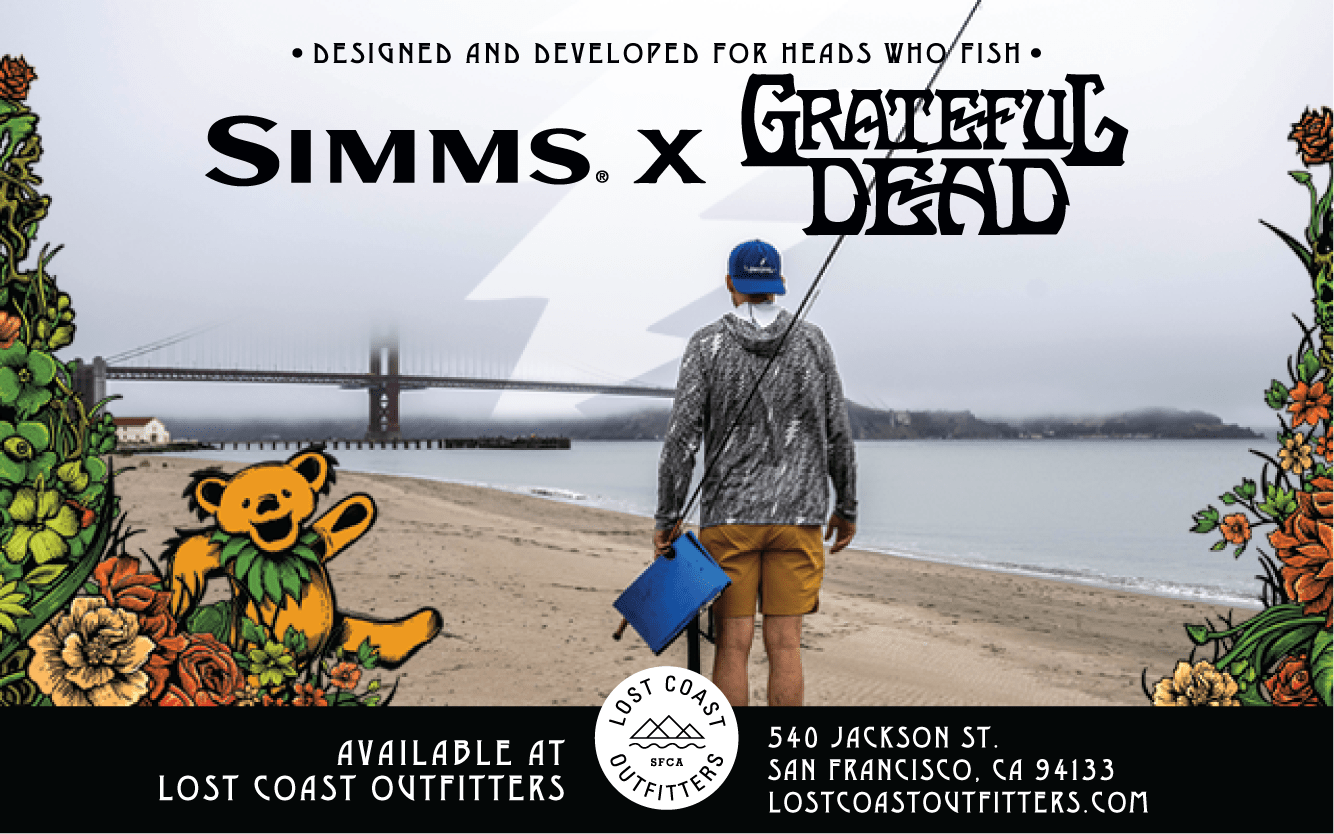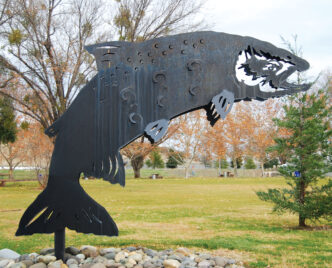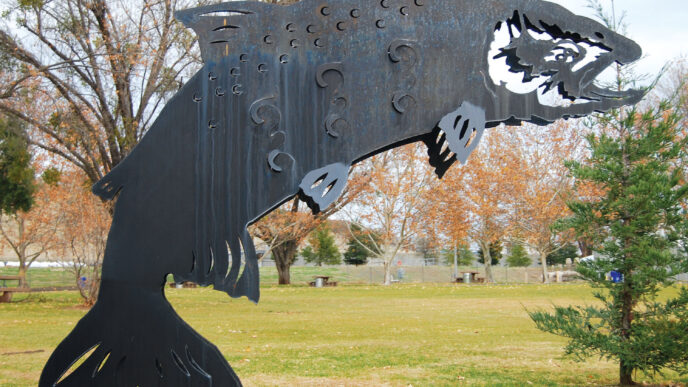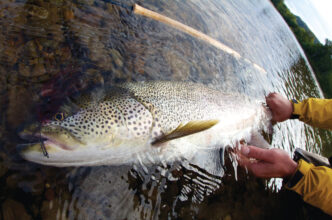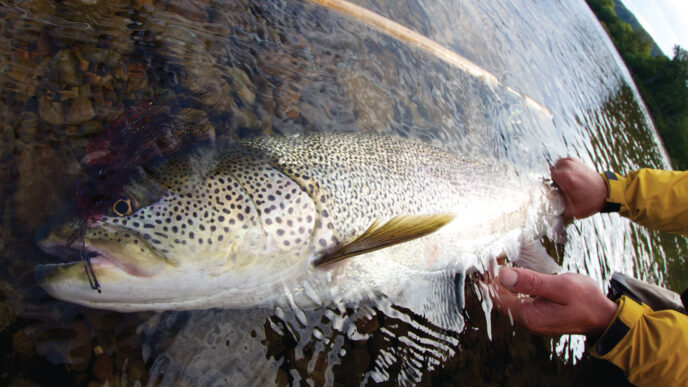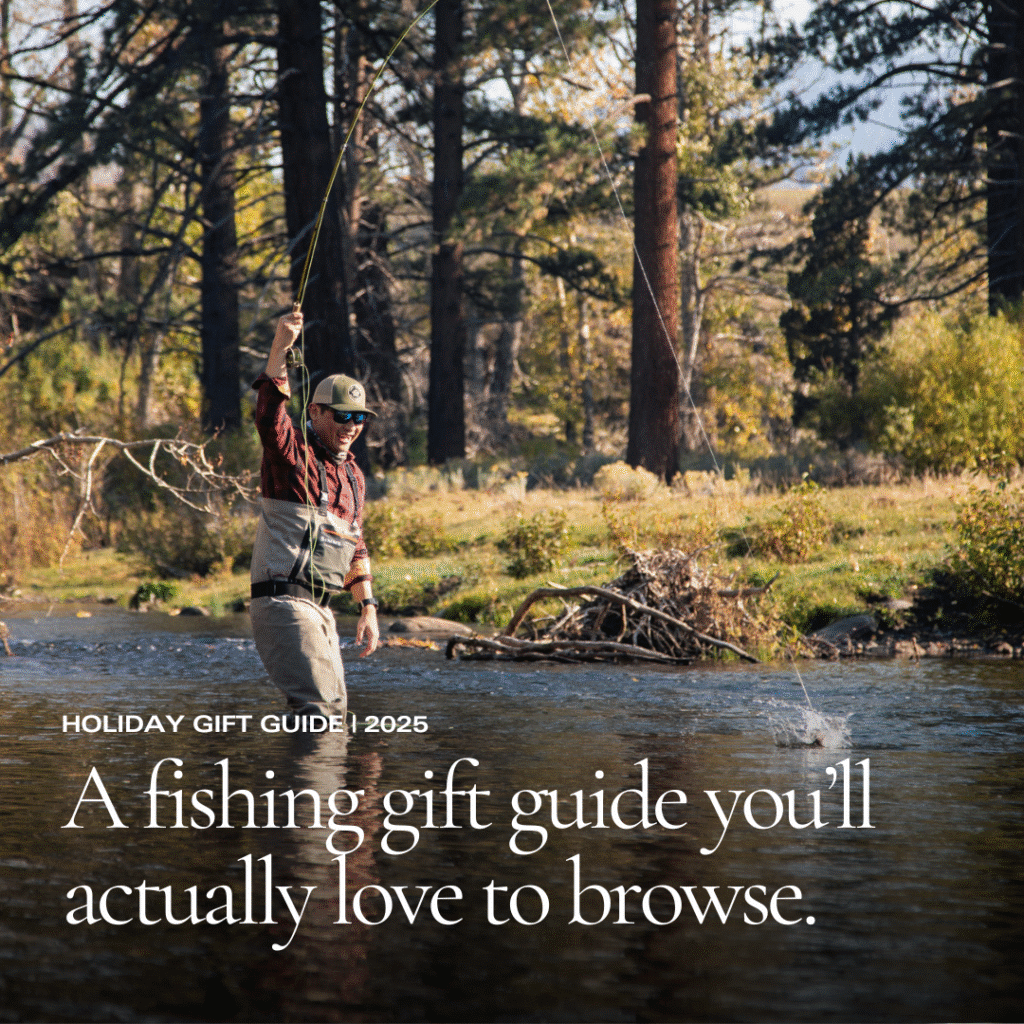As any computer will tell you, there are many Francis J. O’Briens, and even a lot of Chip O’Briens, but as far as California fly fishers are concerned, there is only one Chip. Chip O’Brien has written numerous articles on fishing Northern California waters for California Fly Fisher over the years, as well as for many other publications. If you’ve fished the McCloud or the upper Sacramento at all recently, you may have profited from Chip’s advice, always conveyed in his supple prose style, and you may even have learned what he knows about Northern California waters from his days as a guide. Or maybe you’ve read one of his books — River Journal: Sacramento River (Frank Amato, 1996) and California’s Best Fly Fishing: Streams and Rivers from Northern California to the Eastern Sierra (Headwater Books, 2010). Lately, however, he’s been fishing the Golden State as a knowledgeable tourist, having moved to the Willamette Valley in Oregon. We began by asking him about that move.
Bud: What is with California angling writers moving to Oregon and teaching high school English there? First Scott Sadil does it, and now you. Where you live now, Silverton, Oregon, is supposed to be “the Christmas tree capital of North America” and has been named one of the “Coolest Small Towns in America,” but Google doesn’t turn up much that explains abandoning the upper Sacramento, McCloud, and Pit Rivers.
Chip: No, I did not move to Oregon to write the great American novel or so I could wear Birkenstocks and grow face hair. I moved to Oregon for a woman. Nothing short of female guile could have uprooted me from the phenomenal fishing of Northern California.
Her presentation was flawless, and I still marvel at the finesse with which she coaxed me into thinking it was a good idea to quit fishing all the time, marry her, and get a real job.
We met on one of those Internet dating sites. We played tug-of-war for a few years, my trying to get her to move down to California, she coyly keeping me at arm’s length. When she moved to Silverton, Oregon, in the house next door to her daughter, son-in-law, and grandkids, I realized that I had lost the war. If I wanted her in my life, I would have to move to Oregon. It was worth it.
I’m proud to say it was her writing that first attracted me. In retrospect. I can’t believe I didn’t immediately recognize the steady hand and commanding language of a professional writer. My wife, Marlee LeDai, published her twenty-sixth book a few years ago. Now she teaches writing on the Internet.
Since I had to make a living, and the fishing around Silverton was only so-so, I decided to quit guiding and go back to teaching, which I’d been doing in Redding. The stride from guiding to teaching isn’t as far as you might imagine. A good guide is by definition a good teacher. The prospect of having summers off to fish instead of working was also a tantalizing notion.
The first gig I landed was a temporary teaching position in a juvenile prison. I convinced them I could teach a Language Arts unit on fly fishing, and it was a big hit. Now I’m in my eighth year teaching English and Honors English at Regis High School, a small Catholic school in Stayton, Oregon. Which is ironic, because I was expelled from Catholic school in fourth grade for calling my teacher “Leadbottom” in front of the class. And I had no remorse, either. The mean old biddy deserved it. Another million years in Purgatory for me! I’m also advisor to the Regis Fly Fishers.
Bud: Let’s fill in some more background. In the biographical blurb for River Journal: Sacramento River, you mention a “dubious 14-year digression in corporate sales.” That’s one heck of a digression. What was that digression a digression from? How did it occur, and how did you get back on the right track? How did you end up teaching English? The same blurb says that you started fly fishing at age 10. I gather that fly fishing was part of the right track. But it would seem that so was writing about it. How did two things (interests? skills? obsessions?) that can be quite separate come together?
Chip: I refer to my 14-year dalliance in corporate sales as “dubious” because it took me that long to figure out what’s really important in life. In those days, I thought money was important, until one morning I heard the words “I can’t do this anymore” spill from my own mouth. I was living in Los Angeles, trying to disprove the cliché that money can’t buy happiness. I’d been promoted and transferred by Graebel Van Lines in Wisconsin to call on Los Angeles corporations, especially defense contractors, to handle their relocations. Once I was even named their national salesman of the year, but I was miserable. All I really wanted to do was go fishing and write about it. Even at the height of my sales career, I saw myself as a misplaced fly fisherman, and indeed, I was. Shortly thereafter, I quit my job and moved myself and my family north to Redding.
There, I landed a sales job with a tiny moving company, which lasted only about six months. My heart wasn’t in it. I was finally in fly-fishing nirvana and soon began writing. I worked as a CalTrout regional manager for a few years, but not a very good one. It was not the conservation job I thought it was. It turned out to be a political job, and I lacked the starch to do it well. But I did learn a great deal. Before I knew it, I was guiding, writing, and teaching sixth grade science. I even did a gig as a full-time church youth minister.
My first wife’s sales career was just taking off when we moved out of L.A., a job that required international travel. It worked out well, because I got to spend so much time with my two young sons. I stayed home when she was out of town. When she returned, I was free to guide or just go fishing. Sadly, neither of us recognized at the time the toll this would take on our marriage, which eventually ended after 23 years. Not that all divorces aren’t strange, but ours is unusual in that we are still genuinely good friends, both of us happily remarried. My son Zach lives in Redding where he is (shameless plug) starting a new magazine called Active Norcal. His elder brother Brien (relax, it’s only a nickname) works for National University in San Diego.
When I was a kid growing up in southern Wisconsin, we moved to a home on 80 acres with our own 40-acre lake. In the garage, I found an old bamboo fly rod covered with dust and cobwebs. My mom told me it had belonged to my father, who had died when I was two. It had a red-and-white balsawood bass popper still tied to the petrified leader. Without really knowing what I held in my hand, I took it down to the lake, flipped the popper onto the water, and a big bass annihilated it. I’d like to tell you that I practiced catch and release, but you know better. What I did not suspect at the time was who really got hooked that day.
I subscribed to the three sporting magazines of the day, Outdoor Life, Sports Afield, and Field and Stream and read them all cover to cover as soon as they arrived. The stories about fly fishing were always the first I read.
A love for fly fishing thus led to reading magazines, and that blossomed into a full-on passion for reading all sorts of other literature. One day, my mother looked at me with an earnest expression and said, “You ought to be a writer when you grow up.” Her words stuck. My first piece of serious writing was an essay I wrote to the draft board during the Vietnam War, explaining why I wanted to become a conscientious objector. It worked, and I marveled at what I had done and the awesome power of words.
Even though it would be many years before I started writing professionally, I got a B.S. (how appropriate) in journalism from Bradley University in Peoria, Illinois. That really helped. In journalism school, you learn to live or die by deadlines. Editors quickly identify writers who get their work in on time, and that may be one of the big secrets to getting published. Later, I finished an M.F.A. in creative writing through National University. In fact, son Brien and I went through our master’s programs at about the same time. We went through the graduation ceremony together and got a huge round of applause for being a father-son team.
My first professional work was for Flyfishing magazine, the old Frank Amato publication, in the early 1990s. Richard Anderson was just getting California Fly Fisher off the ground, and he gave me a shot, although I’m pretty sure he rejected the first piece I submitted. Richard’s encouragement and consistently high standards did a lot for me.
Though I had been fly fishing for a lot of years when I moved to Redding, I was largely self-taught. One day, I got to fish with Dick Galland, owner of Clearwater Lodge on Hat Creek, and he suggested I become a guide. It was there, at Clearwater House, that I got to rub waders with some of the most talented fly fishing guides in the West. Many of these friends are still guiding and have more than overtaken whatever skill I might have had on my best day. They are always happy to answer questions I need for articles, bring me up to date with what’s going on, and share a cold one when I’m in town. Writing is not only the fulfillment of a childhood dream for me, but it’s also a way for me to stay connected to my roots and the terrific people who make fly fishing in California what it is.
Bud: As I asked Scott Sadil, has your day job as a teacher had anything to do with your development as a writer? How about being married to an editor and accomplished writer?
Chip: Actually, it was writing that brought me into teaching. My son Zach’s middle school English teacher invited me in to talk to the class about working as a writer. That day, I learned something about myself that I hadn’t previously known. I did not hate teenagers and actually thrived in the frenetic atmosphere of a classroom. Soon I was back to school getting a California teaching credential.
Bud: When I think of the articles that you’ve published in this magazine over the years, the sense I get is of someone who quietly pushes the envelope without making a big deal about it, comes back, and reports on some interesting possibilities you’ve discovered by doing so. As I once asked Conway Bowman about fishing for mako sharks from a kayak, have you ever taken things to the edge and then found yourself on the wrong side of it?
Chip: It’s true that I have a strong wild side and love adventure. I’m the first guy to attempt wading in places I shouldn’t or going underwater in a wetsuit to see what’s down there. I enjoy crazy things, such as jumping out of airplanes. I’ve climbed Mount Shasta numerous times, just to snowboard back down. Of course, I’m not as young as I used to be, but maybe it’s the state of mind that’s really most important, anyway. Even now, I ride a motorcycle almost every day of the year except in blizzards.
I do not want my tombstone to read, “Cause of Death: Stupidity,” so I do a lot of serious homework before taking things to the edge. While I hate quitting anything, I have enough common sense to recognize when things become truly dangerous. That’s saved my bacon a few times. You might say I enjoy feeling fully alive.
One time I was approaching the summit of Mount Shasta on an area of the mountain known as “Misery Hill.” Having traversed the Red Banks, the steepest part of the climb, I could smell the pungent, sulphurous odor of the hot springs just below the summit. It had been a grueling climb, and I longed to be standing at the top. Approaching from the opposite direction was a uniformed man who I learned was a “climbing ranger” whose job it was to keep climbers safe on the mountain.
“I don’t mean to tell you what to do,” he said as he approached, “but if I were you, I’d turn around and head back down the mountain.”
“Oh,” I replied, sure it was some kind of joke, “why is that?”
“The weather’s turning,” he said.
Weather on any large mountain is something only an idiot doesn’t take seriously. But there hadn’t been a cloud in the sky all morning, so I was incredulous. It didn’t make sense.
“It’s entirely up to you,” he added, “but I’m getting off the mountain and suggest you do the same.” Then he marched past me and continued down the slope.
I was flummoxed. This guy was either a fool or he understood something about mountains that I hadn’t yet learned. I sat down to gulp some water and think it over, every molecule of me longing for the final sprint to the summit — so close, yet so far away. I figured I could make it in about another hour, but something also told me this guy was onto something. Choking down frustration and maybe a spoonful of anger, I finally turned around and headed back down. I had never been so close to the summit without making it.
Going downhill is a piece of cake, and a whole lot faster than climbing up. After a good half hour of looking downslope at each new foothold, I stopped to gulp some more water and turned around. The summit was shrouded in dark clouds, the wind was picking up, and from somewhere near the summit, lightning suddenly shattered the tranquility. I could feel the electricity in the air. As much as it pained me to turn around after being so close to the summit, I somehow understood that retreating was the right thing to do and might even have saved my life.
I need only glance at my body to recognize a logbook of events that didn’t go quite as well, though. Some of my favorites include the scar from burying the point of an ice ax in my bicep on Mount Shasta. There is road rash from laying down various motorcycles. There’s a mark from the teenager who buried a bass bug to the shank in my arm. (I just gritted my teeth and yanked.) My proudest scar of all is a human bite, and I’m used to my students begging to see it and for me to tell them the story. The fact that I’m always nursing one scar or another probably reveals all anyone needs to know about my approach to life.
Bud: OK, I’ll . . . uh . . . bite. What is the “human bite” story?
Chip: It was a little fracas I got into while I was living in Pekin, Illinois. Three bikers tried to crash a party I was giving when I was 19. They were drunk and much older than we were. The leader thought his girlfriend was at our party, which she wasn’t, and he demanded to talk with her.
My mom came to the door to tell him he wasn’t welcome at the party, and that’s when he made his mistake. He shoved her out of the way and walked into our house. As I dragged him back out the door, he hit me three times before I got a punch off. When I did connect, it sent him crashing through our garage door. People were still milling all around and I heard someone had called the police. To keep him there, I sat on his chest, which is when he bit my left wrist and held on. I had to knock him unconscious before he let go.
Several minutes later, someone grabbed my shoulder from behind in the darkness. I assumed it was one of his friends, and when I swung around with my fist I knocked that police officer down on the ground. I didn’t know who he was, and he didn’t know who I was. Of course he bounced back with a billy club and thumped me four times on the head. That pretty much took the starch out of my socks. My parents came to my assistance, and the officer and I acknowledged the mistake we had both made. I went off to the hospital, and the biker went off to jail. My head was swollen, but I was sent home with an icepack and no lasting damage. I went to the police station the next day and apologized again to the officer.
Naturally, I asked him about the biker.
Turns out he had recently been released from prison for arson. The officer said his fate was in my hands. If I pressed charges, he would go swiftly and surely back to prison. When I asked my parents what to do, they also said it was up to me.
Well, I’ve always believed in second chances. I did not press charges, and it turned out to be a good choice. He was so trout addiction. For too many, the goal of fishing is still to bring home dinner, and that’s got to change. There are groups such as the Native Fish Society doing some good work up here, but they are not yet as well established as CalTrout. While there is progress being made toward bringing back Oregon native steelhead runs, hatchery steelhead still reign in most anadromous fisheries. Catch-and-release fishing is still the exception, rather than the rule.
As for the fishing itself, I have three current favorite fishing spots in Oregon. The first is the Owyhee River, in the eastern part of the state. It’s a fairly small stream loaded with finicky and huge brown trout. It’s a lot like fishing Hat Creek, only the fish are bigger and the flies even smaller. The landscape looks like it’s out of a John Wayne Western.
The second is the Keno stretch of the Klamath River in south-central Oregon. You pretty much have to float it, and it’s loaded with Class III-plus white water. It’s not impossible to wade, but it’s like a deeper version of the Pit River. It’s also high on the list of people who enjoy seeing rattlesnakes. Oh, and did I mention the redband trout that rival steelhead in both size and vigor? Try stripping a big streamer through this water, and hang on tight.
Finally, I love Mann Lake in Oregon’s Steen Mountains. It’s not the place to go if you enjoy trees (there are none) and often has awful, chilly, nasty, rainy, windy weather that pummels you most of the time and changes every 15 minutes or so. And it’s not near anything. Wait until you connect with a big Mann Lake Lahontan cutthroat trout, though. The weather is forgotten instantly. The fish are large, voracious, and elegant.
There’s something about fly fishing that becomes part of a person. Something elemental inside each person relates to being surrounded by the beauty found in places that have trout, and there are lots of those places in Oregon.
But for me, fly fishing is as much about people as it is about places. Most of the time spent pursuing trout does not involve landing truckloads of big fish, although serendipity strikes every now and then. Not catching fish is a great way to smooth the sharp edges off almost anyone’s ego, which is why I think most fly anglers are such great people. At the very least, they are my people, and I like to stay in touch.
Bud: Still, do you miss having the great fishing of California’s Golden Triangle at your doorstep?
Chip: While I no longer fish as much as I used to, I’ve managed to branch out to fish a much larger geographical area. Over the last few summers, I’ve fished California, Washington, Oregon, Idaho, Montana, and Yellowstone National Park. Getting to know Oregon as well as I know California has been a challenge, but I’m working on it. I can fit all of my fishing (including a float tube) and camping gear on my motorcycle and love nothing more than taking off on extended fishing trips. As much as I love reading books, I had to get a Kindle to save space in my saddlebags.
Bud: Here we are at the dreaded Silly Tree Question. If you were a tree, what kind of a tree would you be?
Chip: If you ask me that question, I’d say you were barking up the wrong one.



